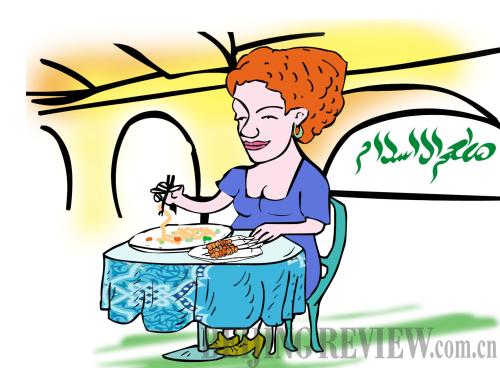|
 |
|
(LI SHIGONG) |
I don't often get the chance to travel to Xinjiang Uygur Autonomous Region, one of China's wildest and most exotic provinces. It's a special place, and I was fortunate enough to have lived there for six months several years ago, when I worked for a Chinese oil company.
The very name Xinjiang—or New Territory—appealed to me with all the lure of the American Southwest, my birthplace. Both regions have small populations, beautiful desert landscapes and multitudes of cultures, religions and borders.
Flying into Urumqi from Ashgabat recently, I saw how fast the city had since developed. Gone was the rowdy, ruffian feel of a "Wild West" town. The city is now super slick, with fancy shopping areas, beautiful stores and elegant restaurants.
So it was that I yearned to find a small, hole-in-the-wall noodle shop where I could watch the proprietor knead a lump of dough, then stretch it out, over and over again, to make those delicious noodles called lamian. Quickly immersed in boiling water and then mixed with a spicy red sauce, chunky like a good Tuscan marinara, my mouth watered at the thought. I walked out into the streets, following my nose.
Ah, yes! Here was the perfect place, packed with people, all happily slurping their noodles. Some people were partaking of daomian—those delicious little wedge-shaped noodles the chef made by deftly slicing his cleaver again some kneaded wheaten dough. How enticing it all was!
I looked to my left as I sat down and saw a party of four eating laji—the Xinjiang primo poultry dish, a huge plate of chicken, the entire bird, chopped into eatable chunks and stir fried in chilies and potatoes. I wanted to eat everything, but stuck to my original plan of pulled noodles.
Leaving, with my tummy stretched tight like an overfed kitten, I wandered around town, digesting my meal. It was decidedly cold, but walking about and watching all the vibrant activity kept me warm. I walked into a shop and saw a vast assortment of carpets, all of fine quality and respectably priced. Dealers offered to ship my purchases anywhere in the world, and I knew they would do so without the slightest mishap.
Years earlier, I'd bought several beautiful Hotan carpets in Kashgar, a famous Silk Road city in China, very near the far western border. At the time, my Muslim rug dealer charged me just pennies extra to ship those treasures home—and I'd known, from his devoutness, that he could be trusted.
The next day, I took the train down to Hami. Everything seemed pretty much the same: Hami, another Silk Road city, lacks the glamour of Kashgar, but it has a fantastic rock market.
Xinjiang is mysterious and rich, full of hidden resources. The desert has given China great oil reserves, and it has also preserved human cultures in the form of artifacts—ranging from pottery to human mummies. To this end, both Urumqi and Hami have great museums to explore.
In Urumqi, there are also even huge meteors from outer space you can touch. And in Hami, I once again trekked to see two beautiful mosques that are centuries old.
In Hami I also found the food to be exquisite. With friends we ate out, sitting in a yurt restaurant, consuming steaming bowls of mutton soup with delicate "sand" rice—a very granular, sweet-tasting rice. Then we had more meat: skewers of twice cooked mutton, with those fragrant Xinjiang spices. Although I am not much of a meat eater, I gorged myself like a tigress nonetheless.
The famous hamigua—the large, fragrant yellow melon, is said to have come from this innocuous town. Centuries ago, envoys sent it by the cartload as part of tributes to their emperor.
A variety of grapes also grow in Xinjiang, especially in nearby Turpan. I'd come too late to enjoy the fruit harvests, but I remembered Turpan's city streets enclosed in grape arbors, shading the residents from the hot summer sun, while providing sweet nourishment. Meanwhile, the ancient irrigation system, called karez, provides water efficiently in these desert cities for crops and human needs. Turpan has many nearby historical sites, ranging from hidden cities to Buddhist holy places.
Indeed, traveling through northwest China has spoiled me. I know south China has many dazzling places to see and experience, but I've made my spiritual choice. The Chinese will tell you their country is divided into beifang and nanfang—the north and the south—and that this difference also implies local meal preferences.
Northern climes, that is, are conducive to the growth of wheat and the herding of sheep; their residents are thus noodle and mutton eaters. Southern climes, meanwhile, facilitate the growth of rice; in these regions people eat more rice and pork.
But my choice is clear: Beijing is my favorite large metropolis and I won't easily go any further south—even to visit Shanghai. It's just too far out of my ken.
The author is an American living in Beijing | 